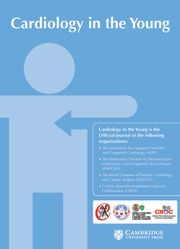No CrossRef data available.
Article contents
Sudden cardiac arrest in an epicardial paced-dependent child: watch out, it’s a pitfall!
Published online by Cambridge University Press: 02 December 2020
Abstract
Coronary artery compression by epicardial leads is a rare complication in children and can be difficult to identify with potentially lethal outcomes. Herein, we report the case of a previously asymptomatic paced-dependant 5-year-old girl who presented to our institution with resuscitated cardiac arrest. We describe the atypical sequence of clinical findings misleading initial diagnosis. Hardware failure and the commonly occurring lead fracture were incriminated in the mechanism of cardiac arrest, precipitating implantation of a new pacing system while concealing dynamic compression of the left anterior descending coronary artery.
Information
- Type
- Brief Report
- Information
- Copyright
- © The Author(s), 2020. Published by Cambridge University Press
References
Fortescue, EB, Berul, CI, Cecchin, F, Walsh, EP, Triedman, JK, Alexander, ME. Patient, procedural, and hardware factors associated with pacemaker lead failures in pediatrics and congenital heart disease. Heart Rhythm 2004; 1: 150–159. doi: 10.1016/j.hrthm.2004.02.020
CrossRefGoogle Scholar
Kubus, P, Materna, O, Gebauer, RA, et al. Permanent epicardial pacing in children: long-term results and factors modifying outcome. Europace 2012; 14(4): 509–514. doi: 10.1093/europace/eur327
CrossRefGoogle ScholarPubMed
Brenner, JI, Gaines, S, Cordier, J, Reiner, BI, Haney, PJ, Gundry, SR. Cardiac strangulation: two-dimensional echo recognition of a rare complication of epicardial pacemaker therapy. Am J Cardiol 1988; 61(8): 654–656. doi: 10.1016/0002-9149(88)90786-2
CrossRefGoogle ScholarPubMed
Riede, FT, Kostelka, M, Dähnert, I. Cardiac strangulation: a rare, but devastating complication of epicardial pacing causing progressive myocardial ischaemia. Eur Heart J 2009; 30(4): 435. doi: 10.1093/eurheartj/ehn449
CrossRefGoogle ScholarPubMed
Macicek, SL, Cannon, BC, Kyle, WB, Krishnamurthy, R, Breinholt, JP, Ing, FF. Dynamic coronary artery compression by pacemaker lead. Circulation. 2011; 124: 1792–1794. doi: 10.1161/CIRCULATIONAHA.110.980243.CrossRefGoogle ScholarPubMed
Carreras, EM, Duncan, WJ, Djurdjev, O, Campbell, AI. Cardiac strangulation following epicardial pacemaker implantation: a rare pediatric complication. J Thorac Cardiovasc Surg 2015; 149: 522–527. doi: 10.1016/j.jtcvs.2014.10.094
CrossRefGoogle ScholarPubMed
Mah, DY, Prakash, A, Porras, D, Fynn-Thompson, F, DeWitt, ES, Banka, P. Coronary artery compression from epicardial leads: more common than we think. Heart Rhythm 2018; 15: 1439–1447. doi: 10.1016/j.hrthm.2018.06.038.CrossRefGoogle ScholarPubMed
Takeuchi, D, Tomizawa, Y. Cardiac strangulation from epicardial pacemaker leads: diagnosis, treatment, and prevention. Gen Thorac Cardiovasc Surg 2015; 63: 22–29. doi: 10.1007/s11748-014-0483-x.CrossRefGoogle Scholar
Alhuzaimi, A, Roy, N, Duncan, WJ. Cardiac strangulation from epicardial pacemaker: early recognition and prevention. Cardiol Young 2011; 21: 471–473. doi: 10.1017/S1047951111000242.CrossRefGoogle ScholarPubMed
Janík, M, Hejna, P, Straka, Ľ, Krajčovič, J, Novomeský, F. Strangulation of the heart presenting as sudden cardiac death: a deadly but forgotten complication of epicardial pacing device. Leg Med (Tokyo) 2018; 32: 107–112. doi: 10.1016/j.legalmed.2018.04.001.CrossRefGoogle ScholarPubMed


